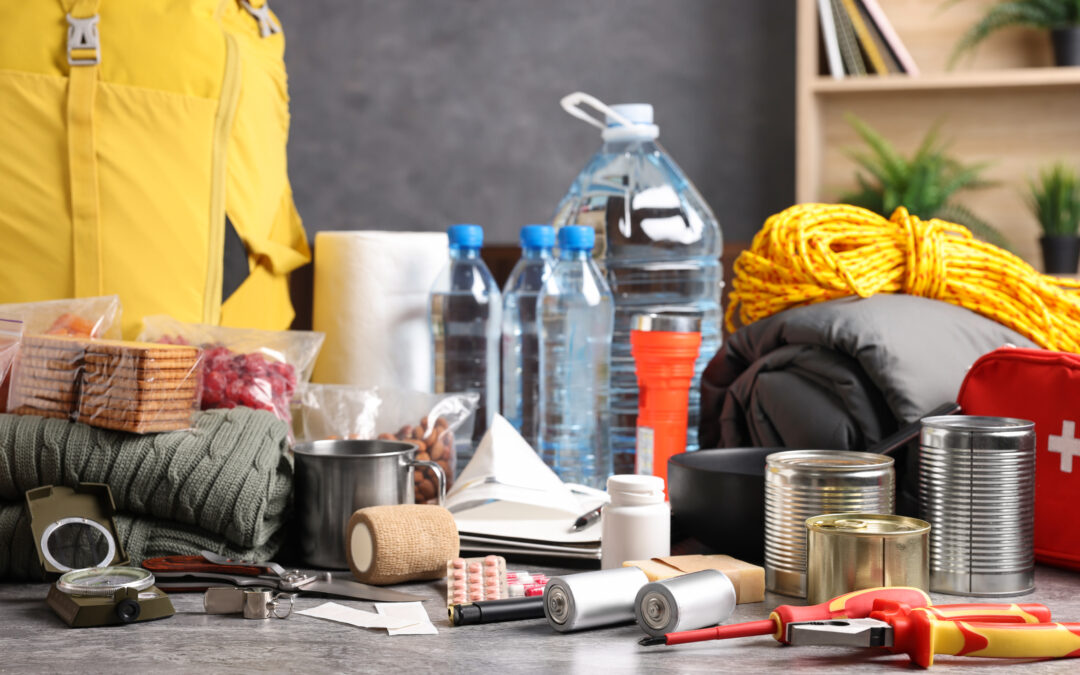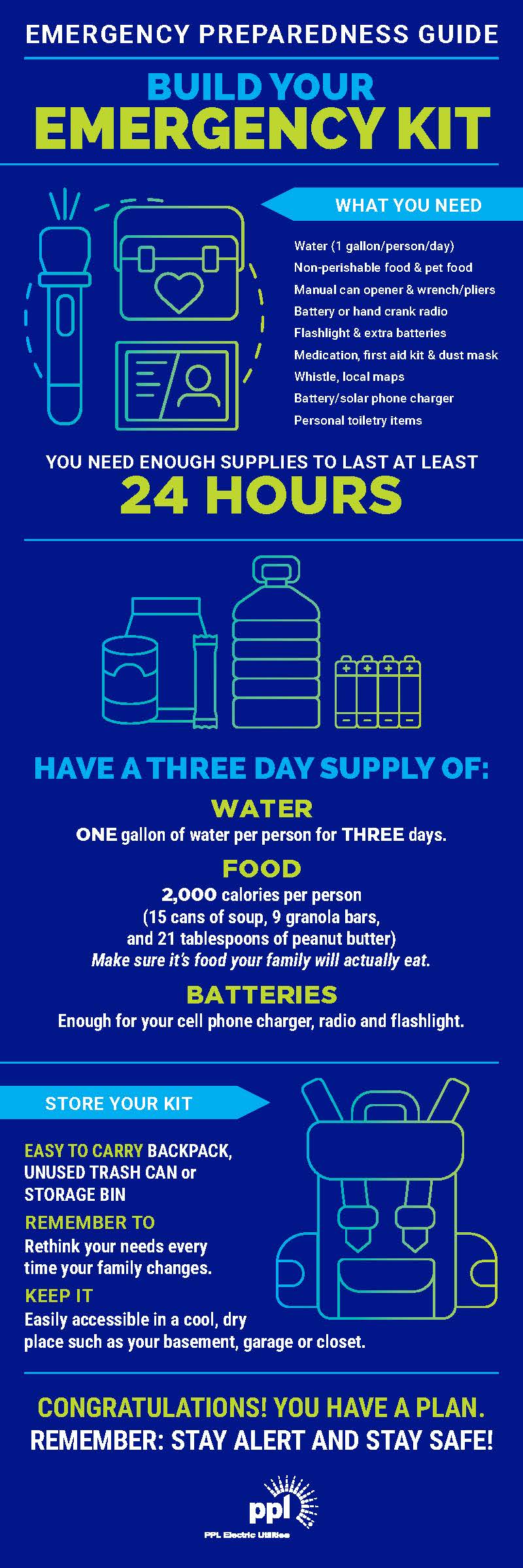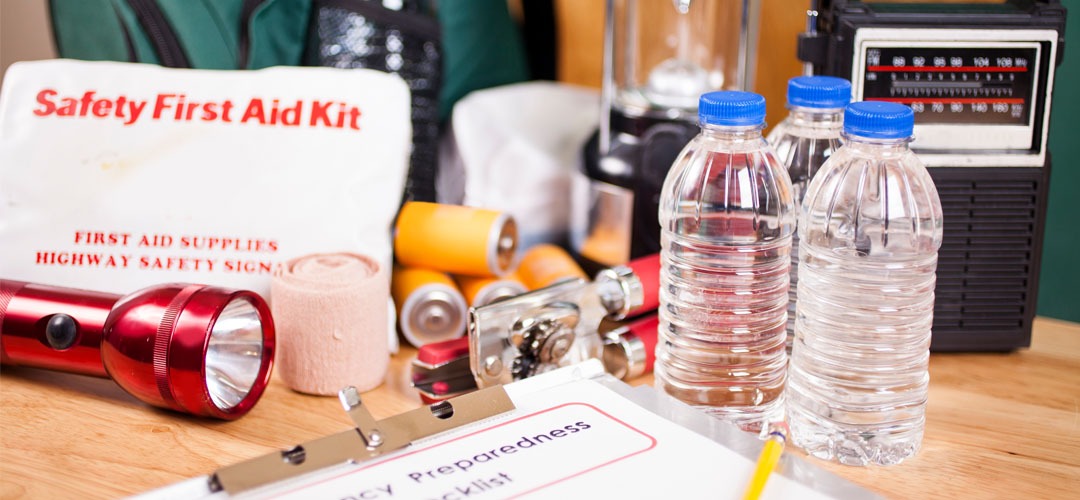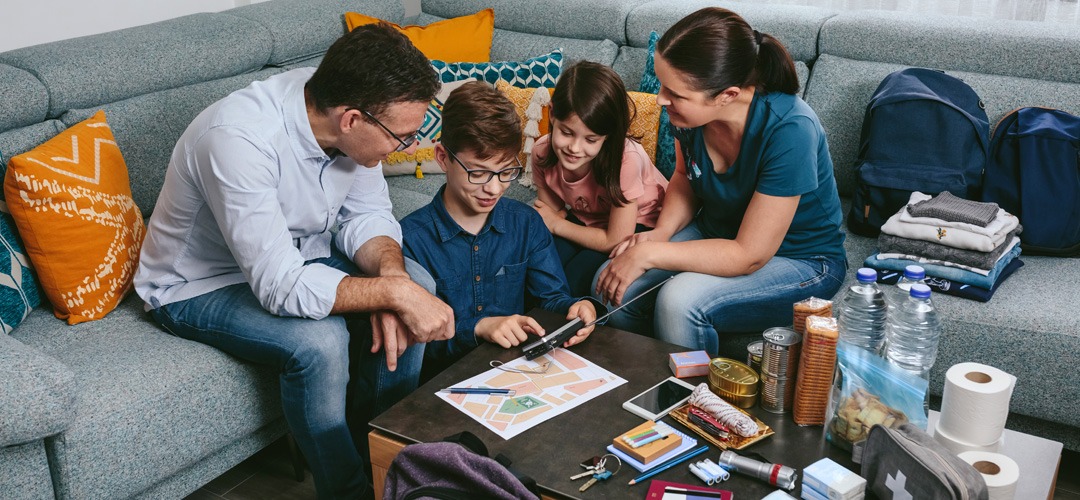
Sep 1, 2025 | Safety and Security
National Preparedness month is a great time to create and review your emergency plan so your family knows what to do during an emergency.
Does your family have a plan in case of a natural disaster or another emergency? You might be surprised to learn that many Americans still don’t.
We take steps every day to keep our loved ones safe. We childproof our homes, buckle up in the car and install smoke detectors. But are we truly ready for an emergency, like a power outage or a severe storm?
What would your family do if the power went out for several days? Do you have enough food, water and other supplies? Every family’s needs are different, and your plan should reflect that. For example, families with young children, pets or someone with medical needs may require extra planning.
Why planning matters
Having a plan in place before an emergency hits can make all the difference. It’s much easier to stay calm and focused when you’ve already thought through the details. Knowing where to go, who to contact and what to have on hand will help you keep your loved ones safe.
National Preparedness Month is a great time to review and update your emergency plan. Even if you already have one, check to make sure it still matches your family’s current needs.
Get started on your plan
If you don’t have a plan yet, now is the perfect time to create one. Ask yourself:
- Does everyone know who to contact and where to go if an emergency happens when you’re not home?
- Do you have an emergency kit with enough supplies for at least three days?
- Does everyone know how to stay informed with the latest news?
- Do you have backup power options, like a generator or battery packs, if an outage lasts longer than expected?
Resources to help you prepare
We’ve gathered essential information from trusted sources like FEMA, the U.S. Department of Homeland Security, the Red Cross and the U.S. Department of Health & Human Services. Our guide combines their best practices into one convenient place, making it easier for you to review and follow.
Key tips:
- Keep a paper copy of your emergency contacts: If your phone dies, you’ll still have access to important numbers.
- Use our checklist to build your emergency kit: It’s designed with all the details you need to be ready.
- Teach your kids what to do in an emergency: Help them stay calm and know what to expect.
Check out the infographics below for more detailed guidance on building your emergency kit and preparing your family.
National Preparedness Month is a reminder to make or update your emergency plan. Being ready helps protect not just you, but everyone who depends on you.


Sep 1, 2025 | Safety and Security
September is National Preparedness Month, and now is the perfect time to make sure you and your family are ready for the unexpected. When emergencies happen, having a well-stocked kit can make a stressful situation easier and safer.
Kit essentials
1. Flashlights and batteries
Have flashlights for everyone in your family and plenty of extra batteries. Flashlights are safer than candles, which can be a fire hazard. Keep one in each room so you’re not searching in the dark.
2. Food and water
Plan for at least three days’ worth of food and water. Stick with non-perishable items like canned goods, granola bars, or dried fruit, and don’t forget a manual can opener. For water, store at least one gallon per person per day for drinking and basic needs.
3. First aid kit
Be ready for minor injuries. Stock bandages, antiseptic wipes, and any prescription medications your family needs. Adding common medicines like pain relievers, cold medicine, and allergy medicine is also helpful.
4. Battery-powered or hand-crank radio
Information is critical during an emergency. A portable radio can keep you updated if the power is out. Be sure to have extra batteries on hand.
5. Blankets and warm clothing
Weather can be unpredictable. Keep extra blankets, sleeping bags and warm clothing like hats and gloves in your kit. Even in summer, a blanket can add comfort.
6. Hygiene items
Good hygiene keeps you healthier in tough times. Include hand sanitizer, wet wipes, toothpaste, toothbrushes, deodorant and other basics. If you have babies or small children, add diapers and wipes.
7. Important documents
Make copies of key documents such as insurance policies, medical information and birth certificates. Store them in a waterproof container along with a list of important phone numbers.
8. Portable phone charger
A portable charger will help you stay connected. Keep it charged so it’s ready when you need it.
9. Cash in small bills
In some emergencies, ATMs and card readers may not work. Having cash on hand — especially small bills — can help you buy supplies or fuel when electronic payments aren’t available.
Putting it all together
Once you’ve gathered your items, store them in a sturdy container like a plastic bin or duffle bag. Keep the kit in an easy-to-reach spot, and make sure everyone in your household knows where it is.
With your emergency kit ready, you’ll have peace of mind knowing you’re prepared for the unexpected. Stay safe, and be ready for whatever comes your way!


Sep 1, 2025 | Storms and Outages
As we enter September, a month dedicated to preparedness, it’s a good time to review how we can best protect ourselves, our loved ones and our community from unexpected emergencies. National Preparedness Month is a reminder that disasters can strike at any time, and being ready can make all the difference.
While we do many things throughout the year to stay prepared for storms and emergencies, we encourage you to do the same.
As your Partners in Power, we’re committed to working together to keep you safe and connected – no matter the weather. Here’s how you can get ready, stay connected and stay safe — before, during and after a storm:
Get prepared:
- Create an emergency plan and discuss what your family would do in different scenarios, such as a power outage, severe weather or other disasters. Identify a meeting place, ensure everyone knows how to contact each other and practice your plan regularly.
- Prepare an emergency kit with food, water, medication, flashlights and pet supplies.
- Charge your phones and devices.
- Make alternate plans if you have a medical condition that requires electricity.
- Purchase power strips with lightning arresters or surge protectors for your appliances and electronics.
- Consider installing lightning rods on your property.
- Review your insurance coverage to make sure it reflects your family’s needs in the event of storm damage.
Stay connected:
- Sign up for local emergency alerts and monitor weather forecasts.
- Report power outages online at pplelectric.com or text “Outage” to TXTPPL (898775).
- Sign up for alerts to stay connected and receive outage updates at pplelectric.com/alerts.
- Check the status of an outage and estimated restoration times at pplelectric.com/outage.
- Follow us on social media for the latest storm and restoration updates.
Stay safe during and after storms:
- Stay away from utility poles and metal conductors.
- If you encounter a downed wire at any time, assume it’s energized and stay away. Report it immediately to PPL Electric.
- Avoid using appliances or electronics plugged into outlets, since electric and plumbing equipment may carry lightning current.
- If using a portable generator during a power outage, never operate it in an enclosed area, like a garage, where deadly carbon monoxide fumes could accumulate.
- Use flashlights instead of candles to prevent fires.
- If you lose power, turn off any appliances that were on when the power went out.
- For your safety and ours, please keep a safe distance from our crews.
How we prepare
At PPL Electric Utilities, we work year-round to strengthen and modernize our grid so it’s ready when storms strike.
We monitor the health of the system through helicopter and drone inspections, and we use sensors and infrared technology to identify needed upgrades and repairs.
We’ve also developed industry-leading smart grid technology that reduces the number of customers affected by outages and automatically reroutes power around trouble spots. Since 2015, more than 3 million outages have been avoided thanks to our smart grid technology. And because trees are the leading cause of outages during storms, we trim and manage vegetation along thousands of miles of power lines each year.
Other reliability improvements include:
- Upgrading power lines and poles with stronger, storm-resistant materials.
- Adding more automated sensors for faster fault detection and restoration.
- Deploying predictive sensors to identify issues before outages occur.
- Installing avian guards and lightning protection along transmission lines.
Storm preparation and response
We monitor weather forecasts daily and plan days ahead when severe weather is expected. As storms approach, we activate storm teams with extra personnel in the field, control centers and customer service. Crews may move to 16-hour shifts for around-the-clock coverage. We dispatch resources across our 29-county service territory to respond as safely and quickly as possible.
When storms cause outages, we follow an established restoration process. Critical facilities like hospitals are restored first. Then we repair lines that bring power back to the largest number of customers, followed by smaller neighborhoods, individual homes and businesses.

Jun 15, 2025 | Safety and Security, Storms and Outages
When the unexpected happens, whether it’s a severe storm, power outage or another emergency, having a well-stocked emergency kit can help you and your family stay safe and comfortable.
What to pack in your emergency kit
- Flashlights and batteries
Keep flashlights in several rooms of your home, and make sure you have extra batteries. Flashlights are safer than candles, especially during outages.
- Food and water
Stock at least a three-day supply of non-perishable food items like canned goods and granola bars. Don’t forget a manual can opener. You’ll also need one gallon of water per person per day for drinking and basic hygiene.
- First-aid kit
Make sure your kit includes bandages, antiseptic wipes and any prescription medications your family needs. Include over-the-counter items like pain relievers and allergy medicine.
- Battery-powered or hand-crank radio
Staying informed is key. A battery-powered or hand-crank radio lets you hear important updates when the power is out. Keep extra batteries on hand.
- Blankets and warm clothing
Pack seasonal clothing and extra blankets or sleeping bags. Even in warmer months, a blanket can provide comfort and protection if you lose power.
- Hygiene items
Include hand sanitizer, wet wipes, toothbrushes, toothpaste, deodorant and other basic items. For families with babies or toddlers, don’t forget diapers and baby wipes.
- Important documents
Store copies of key documents like insurance policies, ID cards and medical information in a waterproof container. It’s also helpful to have a printed list of important phone numbers.
- Portable phone charger
Make sure you have a portable charger to keep your phone powered if the electricity goes out. Keep it charged and ready to go.
Where to keep your kit
Place everything in a large, sturdy container like a plastic bin or duffle bag and store it in an easy-to-reach spot. Let everyone in your household know where it is and what’s inside.


Jun 8, 2025 | Safety and Security, Storms and Outages
Does your family have an emergency plan in case of severe weather? You might be surprised to learn that a lot of Americans don’t have an emergency plan.
We take a lot of steps to keep our loved ones safe. We childproof our homes, buckle up in the car and install smoke detectors. But are we ready for an emergency, like a power outage or a severe summer storm?
What would your family do if the power went out for days during a heat wave? Do you have enough food, water and other supplies? Every family’s needs are different, and your plan should reflect that. For example, families with young children, pets or someone with medical needs might require more detailed planning.
Why planning matters
Having a plan in place before summer storms hit can make all the difference. It’s much easier to stay calm and focused when you’ve thought through the details ahead of time. Knowing where to go, who to contact and what to have on hand will help you keep your loved ones safe.
With storm season approaching, now is a great time to review and update your emergency plan. Even if you already have a plan, it’s important to make sure it still meets your family’s current needs.
Get started on your plan
If you don’t have a plan yet, now is the perfect time to create one. Here are a few questions to ask yourself:
- Does everyone know who to contact and where to go if a summer storm hits when you’re not home?
- Do you have an emergency kit with enough supplies for at least three days?
- Does everyone know how to stay informed with the latest weather alerts?
Resources to help you prepare
We’ve gathered essential information from trusted sources like FEMA, the U.S. Department of Homeland Security, the Red Cross and the U.S. Department of Health & Human Services to create a comprehensive guide just for you. Our guide brings together the best practices and recommendations from these expert organizations into one convenient place, making it easy for you to review and follow.
Key tips:
- Keep a paper copy of your emergency contacts: If your phone dies during a storm, you’ll still have access to important numbers.
- Use our checklist to build your emergency kit: It’s designed with all the details you need to be prepared for summer weather emergencies.
- Teach your kids what to do during a storm emergency: Help them stay calm and know what to expect.
Download our Emergency Preparedness Guide
Check out the infographics below for more detailed guidance on creating your emergency kit and preparing your family. Being prepared for summer storms is essential, not just for yourself, but for everyone who depends on you.









